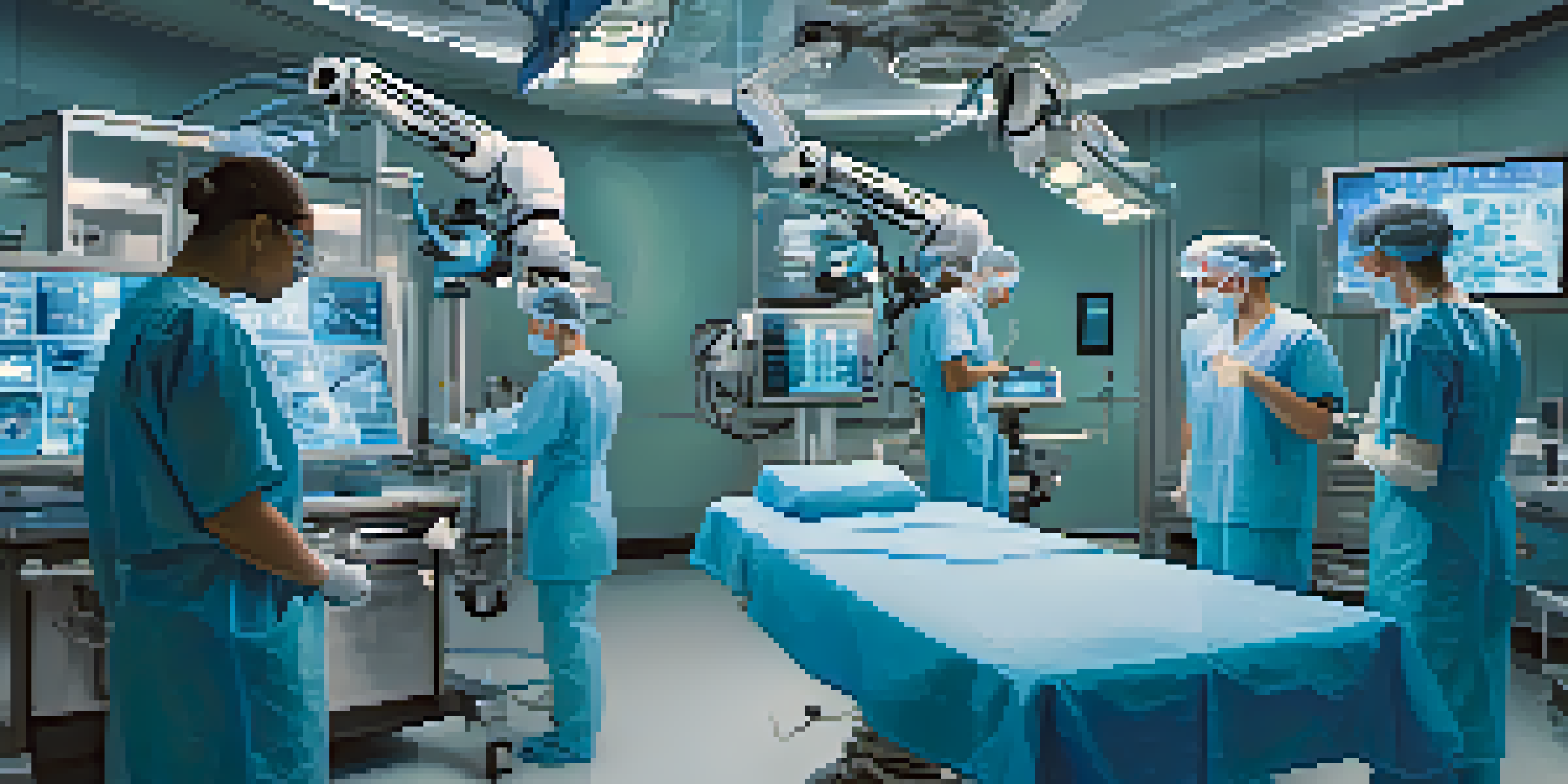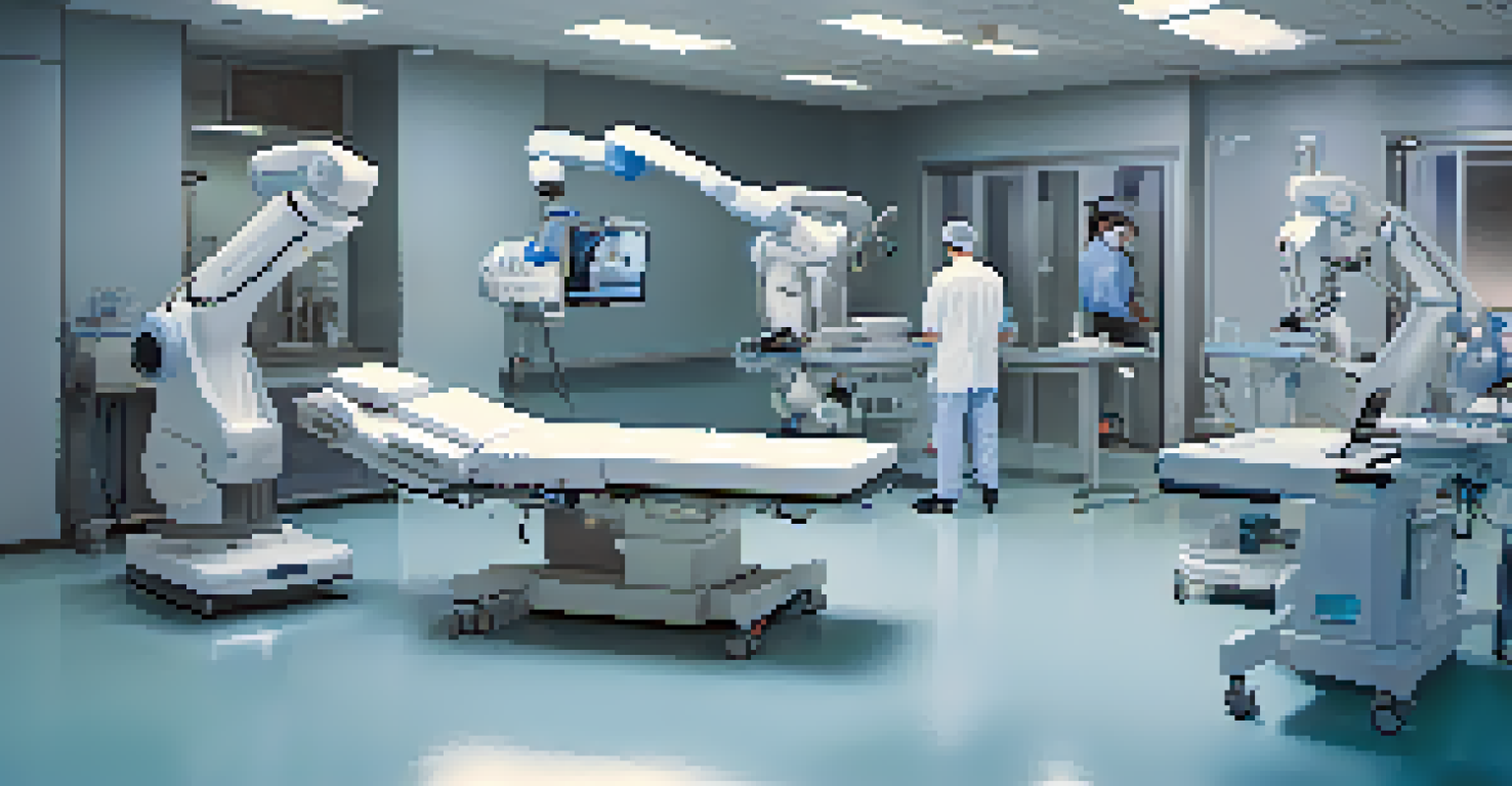The Future of Robotics in Surgery at Houston Medical Institutions

Robotic Surgery: An Overview of Current Technologies
Robotic surgery represents a significant leap in medical technology, providing surgeons with enhanced precision and control. Currently, systems like the da Vinci Surgical System are widely used in various procedures, including urology and gynecology. These robotic systems allow for minimally invasive surgeries, which means smaller incisions, less pain, and quicker recovery times for patients. As Houston medical institutions adopt these technologies, they pave the way for innovative surgical approaches.
Robotics will play a critical role in shaping the future of surgery, allowing for precision and outcomes that were previously unimaginable.
The integration of robotics into surgeries is not just about the machines themselves, but how they complement the skill of the surgeon. These systems provide a three-dimensional view of the surgical site, giving doctors the ability to see details that might be missed with the naked eye. This combination of human expertise and robotic precision can lead to better patient outcomes and shorter hospital stays, which is a win-win for everyone involved.
Looking forward, the future of robotic surgery in Houston hinges on continuous advancements in technology. Researchers are actively working on creating more intuitive interfaces that allow surgeons to operate robotic systems with even greater ease. This means that in the coming years, we may see even more intricate and complex procedures being performed with the assistance of robotics.
The Role of Houston Medical Institutions in Innovation
Houston is home to some of the leading medical institutions in the world, such as the Texas Medical Center, which fosters significant advancements in robotic surgery. These institutions are not only implementing robotic systems but also investing in research and development to push the boundaries of what's possible. Collaborations between hospitals and tech companies are becoming more common, accelerating the innovation process.

For instance, many Houston hospitals are participating in clinical trials that explore new robotic technologies and techniques. These trials ensure that patients benefit from cutting-edge procedures while also providing invaluable data that can improve future surgical practices. The commitment to research and excellence is what sets Houston apart as a hub for medical innovation.
Robotic Surgery Enhances Precision
Robotic surgery improves surgical precision and recovery through minimally invasive techniques, benefiting both surgeons and patients.
Moreover, educational programs in Houston are training the next generation of surgeons to adeptly use these robotic systems. By incorporating robotics into surgical training, Houston institutions are ensuring that future doctors are well-equipped to leverage these advanced technologies, ultimately benefiting patients across the region.
Patient Benefits: Why Robotic Surgery Matters
One of the most compelling reasons for the rise of robotic surgery is the myriad of benefits it offers patients. Minimally invasive procedures typically result in less pain and scarring, which can significantly enhance a patient's recovery experience. For example, patients who undergo robotic-assisted laparoscopic surgery often leave the hospital sooner and return to their normal lives faster than those who have traditional open surgeries.
The integration of technology in medicine not only enhances surgical capabilities but also transforms the patient experience.
In addition to physical benefits, the psychological impact should not be overlooked. Knowing that they are receiving care that utilizes the latest technology can provide patients with a sense of security and reassurance. This confidence can be critical in a patient's overall experience, leading to better satisfaction and adherence to post-operative care.
As robotic surgery becomes more prevalent, it's essential for patients to understand their options. Houston medical institutions are committed to educating their communities about robotic surgery, helping patients make informed decisions about their healthcare. This emphasis on patient education is vital for fostering trust and transparency in the rapidly evolving world of medical technology.
Challenges and Limitations of Robotic Surgery
While the benefits of robotic surgery are significant, there are also challenges and limitations that must be addressed. One of the primary concerns is the cost associated with robotic systems, which can be a barrier for some medical facilities. These advanced technologies require substantial investments, not only for the machines themselves but also for ongoing maintenance and training for surgical staff.
Additionally, there are specific types of surgeries where robotic assistance may not be suitable. Complex cases may still require traditional surgical techniques, as not all procedures can benefit from robotic systems. It’s essential for surgical teams to evaluate each patient’s unique situation carefully to determine the best approach.
Houston Leads in Medical Innovation
Leading medical institutions in Houston are driving advancements in robotic surgery through research, collaboration, and education.
Lastly, the learning curve associated with robotic surgery can pose challenges for new surgeons. While these systems are designed to enhance precision, mastering them requires extensive training and practice. Houston medical institutions are addressing this by providing comprehensive training programs that ensure surgeons are well-prepared to utilize robotic technology effectively.
Future Innovations on the Horizon
The future of robotics in surgery is poised for exciting developments, and Houston institutions are at the forefront of this evolution. Innovations such as artificial intelligence (AI) integration are on the horizon, which could revolutionize how surgeries are performed. AI can assist in surgical planning, helping to predict potential complications and optimize approaches based on patient data.
Another area of innovation includes the development of softer, more flexible robotic tools that can navigate complex anatomical structures with ease. This could lead to advancements in procedures that are currently challenging or impossible with traditional robotic systems. As Houston continues to invest in research and development, the possibilities seem limitless.
Moreover, tele-surgery is an emerging trend that could change the landscape of surgical care. This technology would allow surgeons to operate on patients remotely, making specialized care accessible to people in underserved areas. Houston’s commitment to innovation ensures that they will remain a leader in these groundbreaking advancements.
The Impact of Robotics on Surgical Training
The integration of robotics into surgical training is reshaping how new surgeons are educated. Medical schools and residency programs in Houston are now incorporating robotic simulation into their curricula, allowing students to practice their skills in a risk-free environment. This hands-on training is crucial for developing the dexterity and confidence needed to perform robotic-assisted surgeries.
Simulation technologies provide realistic scenarios that mimic actual surgical procedures, enabling trainees to refine their techniques before working with real patients. As they gain experience through these simulations, they can approach surgery with greater assurance and skill, ultimately leading to better patient care.
Patient Benefits and Education
Robotic surgery offers significant patient benefits, including reduced pain and scarring, while institutions focus on educating patients about their options.
Furthermore, mentorship programs between experienced surgeons and trainees are becoming increasingly important. These relationships foster a culture of learning and collaboration, ensuring that the knowledge and best practices regarding robotic surgery are passed down effectively. Houston’s dedication to nurturing future talent will help sustain the advancements in robotic surgery for years to come.
Conclusion: A Promising Future Ahead
As we look ahead, the future of robotics in surgery at Houston medical institutions appears bright. The combination of advanced technology, skilled surgeons, and a commitment to research and education is creating an environment ripe for innovation. Patients can expect to benefit from safer, more efficient surgical procedures, improving their overall healthcare experience.
While challenges exist, the ongoing efforts to address these issues are a testament to the resilience of the medical community. The focus on collaboration between hospitals, research institutions, and technology companies is crucial for overcoming obstacles and advancing robotic surgery's potential.

In conclusion, Houston stands as a beacon of hope in the realm of robotic surgery, promising a future where medical care is more effective and accessible. As these technologies continue to evolve, patients can look forward to a new era of surgical excellence that prioritizes their health and well-being.